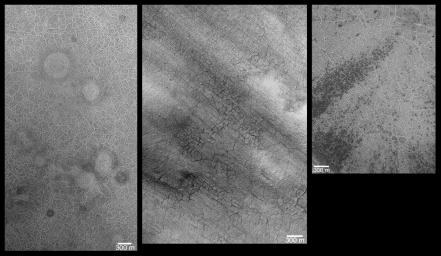
|
Southern Hemisphere Polygonal Patterned Ground
- Click the image above for a larger view
- Full-Res JPEG (2235 x 1298) (915.9 kB)
- Full-Res TIFF (2235 x 1298) (2.9 MB)
Caption:
On Earth, periglacial is a term that refers to regions and processes where cold climate contributes to the evolution of landforms and landscapes. Common in periglacial environments on Earth, such as the arctic of northern Canada,Siberia, and Alaska, is a phenomenon called patterned ground. The "patterns" in patterned ground often take the form of large polygons, each bounded by either troughs or ridges made up of rock particles different in size from those seen in the interior of the polygon. On Earth, many polygons in periglacial environments are directly linked to water: they typically form from stresses induced by repeated freezing and thawing of water, contraction from stress induced by changing temperatures, and sorting of rocks brought to the surface along polygon boundaries by the freeze-thaw processes. Although not exclusively formed by freezing and thawing of water, that is often the dominant mechanism on Earth.
Polygons similar to those found in Earth's arctic and antarctic regions are also found in the polar regions of Mars. Typically, they occur on crater floors, or on intercrater plains, between about 60° and 80° latitude. The polygons are best seen when bright frost or dark sand has been trapped in the troughs that form the polygon boundaries. Three examples of martian polygons seen by the Mars Global Surveyor (MGS) Mars Orbiter Camera (MOC) are shown here. Each is located in the southern hemisphere:
- (left) Polygon troughs highlighted by frost as the south polar cap retreats during spring. The circular features are the locations of buried craters that were originally formed by meteor impact. This image, E09-00029, is located at 75.1°S, 331.3°W, and was acquired on 1 October 2001.
- (center) Summertime view of polygons, highlighted by dark, windblown sand, on the floor of a crater at 71.2°S, 282.6°W. The image, E12-02319, was obtained on 21January 2002.
- (right) Polygon troughs highlighted by the retreating south polar frost cap during southern summer near 80.7°S, 70.4°W. This picture, M11-01795, was taken by MOC on 13 January 2000.
Some Mars researchers assume that polygons on the Red Planet are key indictors that ground ice is present or was present in the recent past. However, whether these polygons actually required water ice to form is, in fact, unknown, since dry processes are also known on Earth for form similar polygons.
Cataloging Keywords:
| Name | Value | Additional Values |
|---|---|---|
| Target | Mars | |
| System | ||
| Target Type | Planet | |
| Mission | Mars Global Surveyor (MGS) | |
| Instrument Host | Mars Global Surveyor | |
| Host Type | Orbiter | |
| Instrument | Mars Orbiter Camera (MOC) | |
| Detector | ||
| Extra Keywords | Crater, Grayscale, Impact, Water | |
| Acquisition Date | ||
| Release Date | 2002-06-07 | |
| Date in Caption | 2000-01-13 | 2001-10-01 |
| Image Credit | NASA/JPL/MSSS | |
| Source | photojournal.jpl.nasa.gov/catalog/PIA03496 | |
| Identifier | PIA03496 | |
